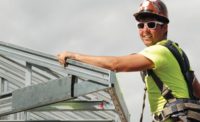Contractors capable of delivering an architect’s vision gain an advantage in the marketplace: they’re able to differentiate and grow. Yet as the complexity of any given project increases, so does the risk. One way to mitigate that risk involves building a project team of subject matter experts—specialists who can leverage both experience and technology in honor of the architect’s design intent.
Horizon Builders recently completed a highly complex residential project that provided just that opportunity. As general contractor for the project, they gathered a team of experts that included architectural BIM specialist, Jaclyn A. Tyler, AIA, LEED AP bd+c, and complex framing design and fabrication leader, Radius Track Corp.
The tech-savvy group focused on five large domes—three exterior and two interior—at the west end of the structure. Each exterior dome intersected the main mansard roof at different points and each dome had different requirements. The GC needed more information about the domes and how they intersected with the main roof than the 2-D construction documents provided. The BIM specialist created a 3-D model based on the construction documents, structural drawings, and field-verified dimensions of the structural frame.
This critical exercise gave shape to the project virtually showing key design elements and their relationships to one another. It revealed that the structure for one of the design elements was constructed slightly smaller than specified. Dedicated to the design intent, Tyler analyzed the original proportions and ratios specified and adapted the size of adjacent elements, which were not yet constructed, to preserve the geometric integrity of the building.
Find the Right Strategy
With the overall building geometry set, the team turned their attention to the dome-to-main-roof-structure intersections. Each of the three exterior domes presented unique connection details. The north dome was the closest to being an entire dome with only one-third cut off by the intersection with the mansard roof. The west dome intersected the roof at the pitch change and required additional strength at the compression ring. This allowed occupants of the room below to look through the opening at the top of the dome, and see into the cupola above. Also, the opening needed to line up with the opening at the top center of the interior dome framing. The south dome presented the easiest intersection. If the mansard roof were vertical rather than slightly sloping, it would have bisected this dome perfectly.
Radius Track created precise 3-D models to identify exactly how each of the three exterior and two interior domes would be framed, connected, constructed, and sheathed to meet the design intent. They provided engineered, prefabricated dome assemblies as a kit of parts, allowing the contractor to ease the risk associated with complex framing of the dome-to-roof intersections. Ultimately, this provided the contractor with everything needed to install the complex framing more efficiently and maintain the project schedule. “We have developed extensive expertise with dome design, engineering and fabrication,” says Ryan Rademacher, VP of design at Radius Track Corp. “Our deep knowledge of complex geometries and our broad experience using 3-D modeling combined to deliver the required precision framing and fabrication solutions on this project. Often we develop an internal BIM to coordinate adjacent materials with our framing scope of work. Having Jaclyn on board made our job that much easier.”
Outsourcing the design and fabrication of the dome framing freed up job site labor to undertake other scope-of-work items. It also improved job safety by shifting CFS metal cutting to an outside entity and decreased job site waste and cleanup activities that would have been associated with the cutting work. By using an experienced fabricator, the GC obtained accurate cost estimates and product lead times, which allowed him to allocate budget and schedule labor accordingly. The 3-D designed and engineered cold-formed steel dome assemblies were easily coordinated with the project’s BIM prior to fabrication, thanks to both Tyler and Radius Track.
“BIM not only gives you the capability to move from design into construction, it allows you to coordinate with all of the trades more easily,” says Tyler. Discussions about dome-to-roof structure connections were facilitated through web-based meetings that allowed each party to see the 3-D dome models and details on their computer screens. This approach meant that issues were anticipated early and eliminated virtually before causing problems on the job site. By the time the dome shop drawings were approved, everyone on the team knew precisely what to expect.
Making the Connection
While the general contractor managed job site workflow, Radius Track fabricated the dome framing elements with computer numeric controlled processes in a controlled environment using data extracted from the manufacturer’s 3-D model. Each framing element was labeled and color coded to match the installation drawings and nomenclature. The connection of the west dome to the roof structure required a specially fabricated plate to pick up the truncated dome ribs. Anticipating installation needs, the fabricator marked the location where each rib connected to the plate. This eliminated the need for the installers to measure and mark each connection point.
“Radius Track Corp. is high performance and low drama,” says Foster Lyons project manager for Horizon Builders. “They coordinated the dome framing design with the 3-D model, fabricated the more than 1,340 framing pieces, and provided 250 sheets of plywood for the custom cut sheathing. They labeled and color coded each piece to match installation drawings, shipped it all in identifiable packages, and supported every phase of this dome project professionally and efficiently without any drama.”
By leveraging a dome framing expert and a BIM specialist, Horizon Builders delivered a project with complex geometry that met the architect’s true design intent. The team anticipated and overcame a critical as-built discrepancy; engineered intricate connection details for the truncated geometry of three different domes with the main mansard roof; and applied proven processes that mitigated risk and assured a high-quality outcome for the contractor. The result is a magnificent home built to the architect’s vision.










Report Abusive Comment